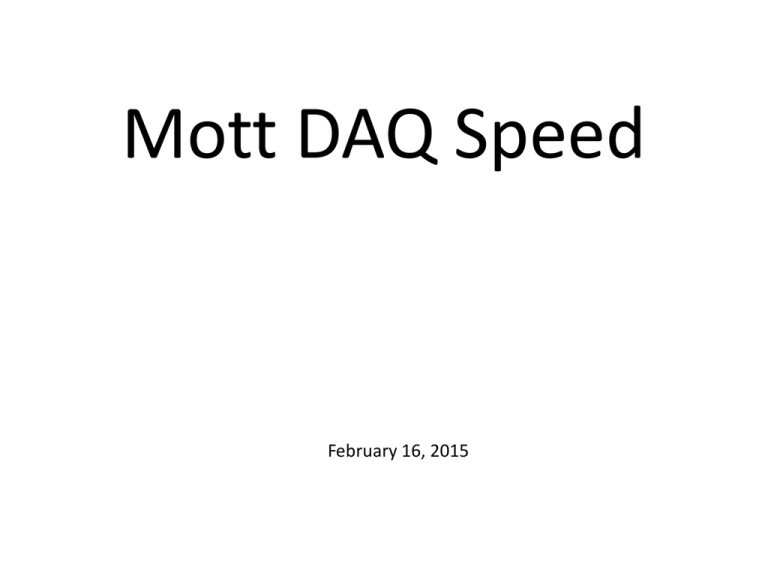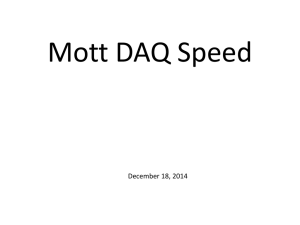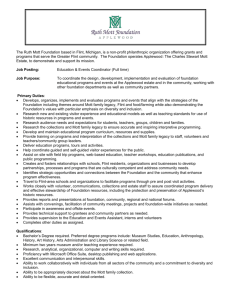Pulse Integral and High Resolution Time
advertisement

Mott DAQ Speed February 16, 2015 VME CRATE (VME8200 9U 21Slot - VME64x backplane with no P0 connector) Gate 1 In 1 1 17 BFM 18 Mott DetTr L1A LEMO 4 L1A ECL 4 Common TRG IN TRG IN Opsmdaq0 FT S2 (SIS3801) S1 (SIS3801) INT FADC DB 2 DB 1 CAEN V538A Mott FADC nT_Settle TDC CAEN V775 BUSY INH TID VME SBC – sbcmdaqo LN1 2 Data Taking Configurations Name Readout Trigger Scalers Scaler S1 (helicity gated), S2 (un-gated) Delayed nT_Settle Mott_Sample Mott FADC (Mode=1), S1, S2, TDC Mott Detector Mott_SemiInt Mott FADC (Mode=7), S1, S2, TDC Mott Detector PEPPo_Int INT FADC, S1, S2 nT_Settle SemiIntFast Mott FADC (Mode=7), BlockLevel=1 Mott Detector SemiIntBlock Mott FADC (Mode=7), BlockLevel=50 Mott Detector 3 Use Faster DAQ Mode • For DAQ to be faster: – No Readout of CAEN V775 TDC or SIS3801 Scalers; only FADC readout – Use block readout • FADC has a mode with smaller data size and time readout: Pulse Integral and High Resolution Time Mode • What about scalers? • We took data with this mode … results are shown next … 4 Comparison of: Raw ADC Data Samples Mode vs. Pulse Integral and High Resolution Time Mode RAW ADC DATA SAMPLES – RUN 8222 6 Raw ADC Data Samples PTW = 100 ns – 2 µs PL = 100 ns – 8 µs Mott Settings: I. Programmable Latency (PL) = 60 samples II. Programmable Trigger Window (PTW) = 50 samples III. Threshold = 0 IV. Each Sample = 4 ns (250 MHz), 0 – 4096 (212) Mott Readout: I. 50 samples 7 Samples 8 Analysis: Pedestals 9 Analysis: Energy σE ~ 3.0% 10 Analysis: Time-of-flight σt ~ 0.3 ns 11 PULSE INTEGRAL AND HIGH RESOLUTION TIME – RUNS 8224, 8235 12 Pulse Integral & High Resolution Time NSB NSA TET PTW PL Mott Settings: I. PL = 60 samples, PTW = 50 samples, NW = NSB + NSA II. Programmable Trigger Energy Threshold (TET) III. Number of pulses (NP) in PTW = 1 (up to 3 pulses) IV. Number of Samples Before threshold crossing (NSB) = 5 V. Number of Samples After threshold crossing (NSA) = 28 13 TET Threshold was 100 for Run 8224 14 Pulse Integral & High Resolution Time VP Vmid NSB NSA TET Pedestal TC PTW PL See Note 1 Mott Readout: I. Pedestal = Average of first 4 samples of window See II. Peak Value (VP) Note 2 III. Pulse Integral = Sum of raw samples MIN(NSB+NSA, PTW) IV. Pulse Coarse Time = Sample number N1 such that V(N1) ≤(Vp-Ped)/2)<V(N2) 15 V. Pulse Fine Time = 64 ( Vmid – V(N1) )/( V(N2)-V(N1) ). From 0 to 63 in steps of 62.5 ps Pulse Pedestal 16 Pulse Peak Value (VP) 17 Pulse Integral 18 Pulse Coarse Time See Note 3 19 Pulse Fine Time 20 Analysis: Pedestals 21 Analysis: Energy σE ~ 3.0% 22 Analysis: Self Timing Peak T->Draw("(TimeCoarse11*4.0 + TimeFine11*0.0625) - (TimeCoarse1*4.0 + TimeFine1*0.0625) >> h1", "TimeCoarse1>1.0 &&TimeCoarse11 >1.0") σt ~ 0.3 ns 23 Analysis: E-dE Timing Peak T->Draw("(TimeCoarse5*4.0 + TimeFine5*0.0625) - (TimeCoarse1*4.0 + TimeFine1*0.0625) >> h1", "TimeCoarse1>1.0 &&TimeCoarse5 >1.0") σt ~ 0.40 ns 24 Analysis: Time-of-flight T->Draw("(TimeCoarse1*4.0 + TimeFine1*0.0625) - (TimeCoarse9*4.0 + TimeFine9*0.0625) >> h1", "TimeCoarse1>1.0 &&TimeCoarse9 >1.0") Use CH1-CH4 25 Analysis: Time-of-flight T->Draw("(TimeCoarse11*4.0 + TimeFine11*0.0625) - (TimeCoarse9*4.0 + TimeFine9*0.0625) >> h1", "TimeCoarse1>1.0 &&TimeCoarse9 >1.0 ") Use CH11 26 Analysis: Time-of-flight T->Draw("(TimeCoarse11*4.0 + TimeFine11*0.0625) - (TimeCoarse9*4.0 + TimeFine9*0.0625) >> h1", "TimeCoarse1>1.0 &&TimeCoarse9 >1.0 &&VPeak9>0.0") Use CH11 27 Three Timing Signals • Added two more laser timing signals to FADC. • From Disc 708, OUT signal was connected to FADC Ch10 and OUT_bar was connected to Ch12. • Original laser timing signal is still connected to Ch9. 28 Analysis: Time-of-flight - 8235 T->Draw(“(TDC17-TDC18)>>h1”,”VPeak1>600”) 29 Analysis: Time-of-flight - 8235 T->Draw("(TimeCoarse1*4.0 + TimeFine1*0.0625) - (TimeCoarse10*4.0 + TimeFine10*0.0625) >> h1", “VPeak1>600&&VPeak10>0.0") T->Draw("(TimeCoarse1*4.0 + TimeFine1*0.0625) - (TimeCoarse12*4.0 + TimeFine12*0.0625) >> h1", “VPeak1>600&&VPeak12>0.0") Use CH10 or Ch12 30 Notes Note 1 If any of the first four samples above threshold then: course time =1, fine time = 0, ped = 0, and VPeak = 0 Note 2 MIN(NSB+NSA, PTW): Make sure NSB+NSA is less than PTW. Otherwise from CODA readout, cannot tell how many samples were summed; this is needed for pedestal subtraction. Note 3 How FADC deal with a periodic square wave. Possible Solutions: I. Use signal and signal_bar – Run 8235 (does not seem to work because of Note 1) I. Add same signal to another channel delayed by ½ period bad good PTW PL 31 Conclusions – so far … • Pulse Integral and High Resolution Time Mode has good energy and time resolutions. Must have: – Correct FADC parameters: Threshold, NSB, NSA – How to deal with a periodic signal? • Again, what about scalers? • A new CODA Configuration was created with this mode (no CAEN v775 TDC and no SIS3801 Scalers) with block readout. Next … 32 Conclusions – so far … • Measure deadtime with 2.2 uA on 1 um gold foil: I. Run 8225: Mott_SemiInt configuration (FADC+TDC+Scalers), Deadtime = 28% at 5.1 kHz. II. Run 8227: SemiIntFast configuration (only readout of FADC, Blocklevel = 1) , Deadtime = 17% at 5.1 kHz. III. Run 8228: SemiIntBlock configuration (only readout of FADC, Blocklevel = 50) , Deadtime = 1% at 5.1 kHz. Learn how to unblock and analyze 33






